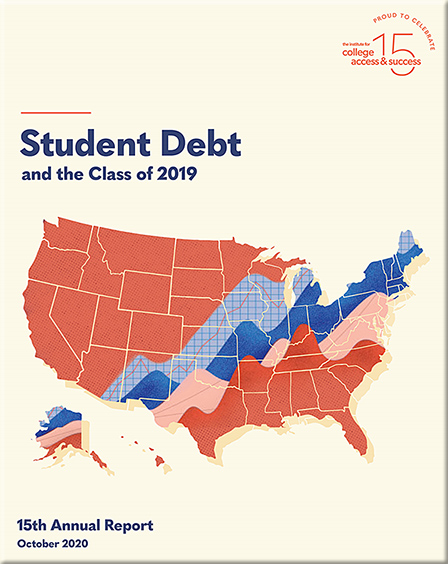Some resources mentioned by Goldie Blumenstyk out at “The Edge” — in her posting entitled “How to Keep Old Debts From Deterring Returning Students“
- Institute for College Access & Success (Ticas) has just released its annual report on what college graduates owe in student debt.
Excerpt:
Student Debt and the Class of 2019 is TICAS’ fifteenth annual report on the student loan debt of recent graduates from four-year colleges, documenting changes and variation in student debt across states and colleges. Unless otherwise noted, the figures in this report are only for public and private nonprofit colleges because virtually no for-profit colleges report what their graduates owe.Nationally, more than six in ten (62%) college seniors who graduated from public and nonprofit colleges in 2019 had student loan debt, down from the Class of 2018 (65%). Borrowers from the Class of 2019 owed an average of $28,950, a 0.9 percent decline from the average of $29,200 in 2018, continuing a trend of relatively flat student debt levels in recent years.
Solving Stranded Credits: Assessing the Scope and Effects of Transcript Withholding on Students, States, and Institutions — from sr.ithaka.org by Julia Karon, James Dean Ward, Catharine Bond Hill, & Martin Kurzweil
Excerpt:
Attention to the burden of U.S. educational debt, now at $1.7 trillion, has grown in recent years.[1] For too many former postsecondary students—especially Black students—debt they took on to improve their lives and career prospects has instead become a financial hindrance, delaying or undermining their efforts to buy homes, build savings, or provide for their families.[2] The debt burden is especially severe for those who never completed their postsecondary program and therefore did not receive the credentials that might have boosted their careers and incomes enough to justify taking on the debt.
Also see:
- The pandemic has pushed hundreds of thousands of workers out of higher education — from chronicle.com by Dan Bauman
Excerpt:
The work-force that serves much of higher education in America has shrunk by at least 7 percent since Covid-19 arrived on American shores — a staggering, unprecedented contraction, according to federal data. And like the national economic downturn that is running parallel to this unprecedented viral outbreak, much also remains uncertain about what a “recovery” will actually look like for higher education.









